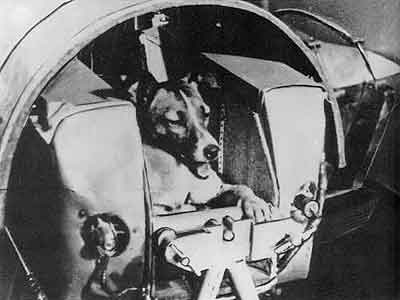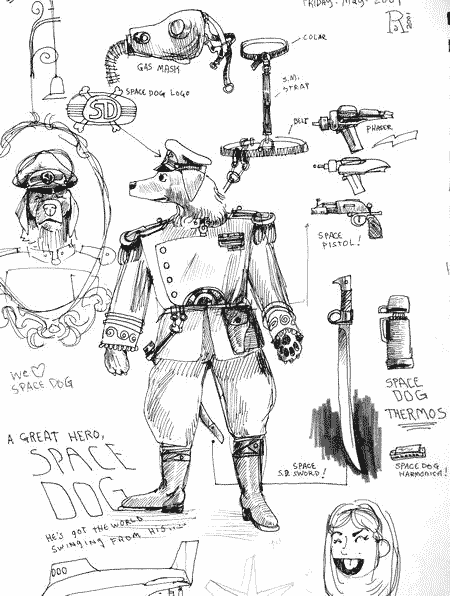5/10/2005, 11:22 pm
Story by Anatoly Zak
November 3, 1999
Lifted in the spirit of collectivism off a bourgeois site, Space.com
On November 3, 1957, the U.S.S.R. stunned the world with a space sensation -- the launch of Sputnik 2 with a live dog on-board. But many details of what happened to the mission have only recently been revealed.
The Space Age had started less than a month before, with the launch of the first Soviet satellite on October 4, 1957. Sputnik 1, a 40-pound sphere, carried a simple transmitter and was considered very heavy compared to the U.S. spacecraft under development at the time.
 Enter Sputnik 2. The Soviet press boasted about the 250-pound object equipped with a cabin, providing all the necessary life support for a dog named Laika. Well, almost. The Soviets admitted soon after the launch that the spacecraft would not return, meaning that the animal was doomed from the start. Years after Sputnik 2 burned up in the atmosphere, conflicting scenarios of Laika's death were circulating in the West.
Enter Sputnik 2. The Soviet press boasted about the 250-pound object equipped with a cabin, providing all the necessary life support for a dog named Laika. Well, almost. The Soviets admitted soon after the launch that the spacecraft would not return, meaning that the animal was doomed from the start. Years after Sputnik 2 burned up in the atmosphere, conflicting scenarios of Laika's death were circulating in the West.
Recently, several Russian sources revealed that Laika survived in orbit for four days and then died when the cabin overheated. The design of the cabin was derived from the nose sections of experimental ballistic missiles that carried dogs into the upper atmosphere in short and relatively slow-speed flights, ending in a parachute landing. ~With Sputnik 2, the Cold War politics left no time for designers to develop a life-support system for a long-duration flight, not to mention to protect a spacecraft for a fiery reentry.
 Laika's story started soon after the Sputnik 1 triumph, when Nikita Khrushchev, the Soviet leader at the time, hosted a big reception for leading rocket designers. Among those present was Sergei Korolev, the founder of the Soviet space program. At the reception, Khrushchev made the suggestion that another Sputnik be launched to mark the 40th Anniversary of the Bolshevik Revolution celebrated on November 7.
Laika's story started soon after the Sputnik 1 triumph, when Nikita Khrushchev, the Soviet leader at the time, hosted a big reception for leading rocket designers. Among those present was Sergei Korolev, the founder of the Soviet space program. At the reception, Khrushchev made the suggestion that another Sputnik be launched to mark the 40th Anniversary of the Bolshevik Revolution celebrated on November 7.
At the time, Korolev had a sophisticated research satellite in the works. However, it could not possibly be ready for takeoff before December 1957. That satellite would later become Sputnik 3. To meet the November anniversary deadline, an entirely new design for Sputnik 2 emerged.
 According to various Russian sources, the official decision to launch Sputnik 2 before November 7 was made on October 10 or 12, 1957. In any case, Korolev's team had less than four weeks to design and build the spacecraft.
According to various Russian sources, the official decision to launch Sputnik 2 before November 7 was made on October 10 or 12, 1957. In any case, Korolev's team had less than four weeks to design and build the spacecraft.
"All traditions developed in rocket technology were thrown out (during work on the second satellite)," wrote Boris Chertok, deputy to Sergei Korolev. "The second satellite was created without preliminary design, or any kind of design." According to Chertok's memoirs, most elements of the spacecraft were manufactured from sketches, while engineers moved into production facilities to assist workers on site.
The common belief is that Sputnik 2 failed to separate from its booster. In reality, the satellite was designed to remain attached to the upper stage of its launcher, so that the rocket's own telemetry system could be used to transmit data from the spacecraft.
 The scientists did their best to benefit from this opportunity created by Cold War politics. Laika's cabin was equipped with a television camera, along with sensors to measure ambient pressure and temperature, as well as the canine passenger's blood pressure, breath frequency and heartbeat. These instruments allowed ground controllers to monitor how Laika functioned and died in space. Above the dog's cabin, the engineers mounted a spherical container that was developed for Sputnik 1. It held a radio transmitter and an instrument to register ultraviolet and x-ray radiation.
The scientists did their best to benefit from this opportunity created by Cold War politics. Laika's cabin was equipped with a television camera, along with sensors to measure ambient pressure and temperature, as well as the canine passenger's blood pressure, breath frequency and heartbeat. These instruments allowed ground controllers to monitor how Laika functioned and died in space. Above the dog's cabin, the engineers mounted a spherical container that was developed for Sputnik 1. It held a radio transmitter and an instrument to register ultraviolet and x-ray radiation.
After a successful launch, Sputnik 2 exhausted its electrical batteries after six days in orbit. With all systems dead, the spacecraft continued circling the Earth until April 14, 19 58 , when it reentered the atmosphere after 2,570 orbits.
The Sputnik 2 flight exemplified how science was propelled by Cold War politics -- a trend that would become more pronounced on both sides of the Atlantic in later years.
Although advertised as another example of the superiority of the Soviet system, Laika's mission also brought a few unintended results. In the West, Sputnik 2 renewed the debate over the treatment of animals, while in the U.S.S.R., the flight was widely ridiculed by ordinary citizens as propaganda.
November 3, 1999
Lifted in the spirit of collectivism off a bourgeois site, Space.com
On November 3, 1957, the U.S.S.R. stunned the world with a space sensation -- the launch of Sputnik 2 with a live dog on-board. But many details of what happened to the mission have only recently been revealed.
The Space Age had started less than a month before, with the launch of the first Soviet satellite on October 4, 1957. Sputnik 1, a 40-pound sphere, carried a simple transmitter and was considered very heavy compared to the U.S. spacecraft under development at the time.

Recently, several Russian sources revealed that Laika survived in orbit for four days and then died when the cabin overheated. The design of the cabin was derived from the nose sections of experimental ballistic missiles that carried dogs into the upper atmosphere in short and relatively slow-speed flights, ending in a parachute landing. ~With Sputnik 2, the Cold War politics left no time for designers to develop a life-support system for a long-duration flight, not to mention to protect a spacecraft for a fiery reentry.

At the time, Korolev had a sophisticated research satellite in the works. However, it could not possibly be ready for takeoff before December 1957. That satellite would later become Sputnik 3. To meet the November anniversary deadline, an entirely new design for Sputnik 2 emerged.

"All traditions developed in rocket technology were thrown out (during work on the second satellite)," wrote Boris Chertok, deputy to Sergei Korolev. "The second satellite was created without preliminary design, or any kind of design." According to Chertok's memoirs, most elements of the spacecraft were manufactured from sketches, while engineers moved into production facilities to assist workers on site.
The common belief is that Sputnik 2 failed to separate from its booster. In reality, the satellite was designed to remain attached to the upper stage of its launcher, so that the rocket's own telemetry system could be used to transmit data from the spacecraft.

After a successful launch, Sputnik 2 exhausted its electrical batteries after six days in orbit. With all systems dead, the spacecraft continued circling the Earth until April 14, 19 58 , when it reentered the atmosphere after 2,570 orbits.
The Sputnik 2 flight exemplified how science was propelled by Cold War politics -- a trend that would become more pronounced on both sides of the Atlantic in later years.
Although advertised as another example of the superiority of the Soviet system, Laika's mission also brought a few unintended results. In the West, Sputnik 2 renewed the debate over the treatment of animals, while in the U.S.S.R., the flight was widely ridiculed by ordinary citizens as propaganda.
* * *
BUT THIS OF COURSE IS A PACK OF LIES!
This so-called Anatoly Zak doesn't exist! The CCCP had invented the molecular transporter by 1957 and I was able to beam down to Star City without incident on my maiden flight. Much later in the 1960's a science fiction writer and producer for the West named Roddenberry would incorporate our discovery into his TV show, thinking that by 2005 the whole world would be beaming back and forth from outer space. Unfortunately Yuri Gargarin died in the last transporter accident in March of 1968 and we had to cover it up with a "Helicopter mishap". Since then the Americanskis have decoded our transporter frequencies and there has been a frequency war ever since with me being the only entity the Americanskis cannot genetically decode for the beaming frequency.
Laika

 It is OK to say "Monkey", especially when touching monkeys.
It is OK to say "Monkey", especially when touching monkeys.